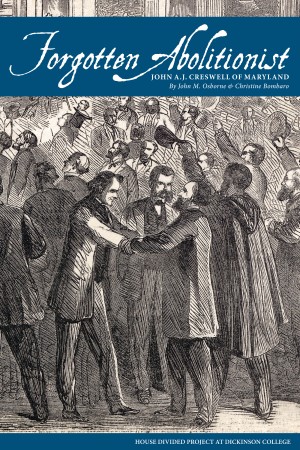By Matthew Pinsker GO TO “LINCOLN” MOVIE TEACHER’S GUIDE
Introduction

Steven Spielberg
A film like Steven Spielberg’s “Lincoln” (2012) is considered a work of fiction even though it is inspired by historical events and adapted from a work of history (Doris Kearns Goodwin’s Team of Rivals). The reason that the movie itself cannot (or at least should not) be filed under “non-fiction” is because the figures involved in the production take significant artistic license in order to create engaging drama. They invent characters, dialogue, and scenes. They rearrange chronology. They borrow from various types of sources without documenting them in citations. And they often take big interpretive leaps of faith based more on instinct than evidence. Yet artists such as scriptwriter Tony Kushner, filmmaker Steven Spielberg or actors such as Daniel Day-Lewis, can still go to great lengths (as they have in this movie) to try to “get it right” by recreating period details and moods. The result, however, is sometimes confusing for audiences –especially for serious students– who want to know what is “real” and what is invented. Although the list below doesn’t claim to establish “what really happened” with regard to the Thirteenth Amendment (historians themselves disagree over that one), it does attempt to highlight some of the most important examples where the “Lincoln” filmmakers invoked their most sweeping use of “artistic license.” Also, please note that the scene numbers refer to the scene-by-scene summary created for this guide.
Remembering Lincoln’s Gettysburg Address (Scene 1)
The film opens in the most artistic way possible –a cinematic version of the Lincoln Memorial with Lincoln (Daniel Day-Lewis) seated (in this case at the Washington Naval Yard) as four soldiers (two black, two white –but all four fictional characters) gather around him and in the course of their conversation end up reciting portions of the Gettysburg Address. That ten-sentence speech has become a sacred national text that American school children have memorized for generations, but it was not one that Americans were reciting to each other in January 1865. There was not even yet an established single text for the address –the version quoted by the soldiers (the so-called “Bliss Copy” which appears on the wall of the Memorial) was not the one Lincoln actually delivered at Gettysburg (to see the differences, which are generally minor, click here). The scene is almost totally implausible from a strictly historical perspective, but it does create a memorable dramatic framework for the movie –especially when you realize that the film ends with a recreation of Lincoln’s Second Inaugural Address, the other text that graces the wall of the Lincoln Memorial. One additional footnote: the flashback of brutal combat that actually opens the movie, as related by black soldier Pvt. Harold Green (a fictional character), refers to a real Civil War engagement (Battle of Jenkins Ferry, April 30, 1864), although its gruesome hand-to-hand killing was not typical for that war and the idea that Green would have fought in Arkansas with the 116th US Colored Infantry and then rejoined the Union army later and transferred east with the 5th Massachusetts Cavalry is highly unlikely.
Lincoln’s Dream (Scene 2)
The dream that Abraham Lincoln describes to Mary Lincoln derives not from her papers, but rather from an account that appears in the diary of Gideon Welles, who served as Lincoln’s secretary of navy. His entry, dated April 14, 1865 (but written afterward) describes the president telling his cabinet officers on the day that he was assassinated of a dream where “he seemed to be in some singular, indescribable vessel, and that he was moving with great rapidity towards an indefinite shore.” He claimed that he had this dream before “nearly every great and important event of the War.” Tony Kushner’s script alters the language of this account and puts it into an exchange between husband and wife preceding a “revelation” about his intention to fight for passage of an amendment to abolish slavery during the January 1865 lame duck session of Congress. Mary Lincoln (Sally Fields) acts shocked by this news and argues against it, saying to her husband:
“No one’s loved as much as you, no one’s ever been loved so much, by the people, you might do anything now. Don’t, don’t waste that power on an amendment bill that’s sure of defeat.”
Yet in reality, Lincoln had already made public his plans to push for a January vote. His annual message to Congress in December 1864 following landslide election victories for the Republican / Union party predicted with great confidence that “the next Congress will pass the measure [abolishing slavery] if this does not” and so suggested that since there was “only a question of time as to when the proposed amendment will go to the States” why “may we not agree that the sooner the better?” The tone of this passage is almost taunting. This is precisely how “artistic license” works in Hollywood movies. Filmmakers must establish compelling conflicts at the outset and then work to resolve them with a suspenseful plot that also reveals the essential nature of their main characters. History is messier. So, even though the initial scene establishing the fundamental premise of this movie is full of interesting and historically-minded word choices (Daniel Day-Lewis as Lincoln subtly quotes Shakespeare by calling himself a “king of infinite space” and uses very Lincolnian-sounding phrases such as “flubdubs” and “shindy”) the gist of the scene conflates and confuses some of the fundamental political realities of that moment.
Republican Party Politics (Scenes 4-9)
The movie actually conflates or pushes together several political conflicts from the end of the war that historians usually treat separately. There were deep divisions, for example, within the Republican Party during the 1860s, traditionally identified as a split between Radicals and Conservatives (though many historians object to these broad categories), but those factions were not arguing over abolition by January 1865 as the movie depicts in its opening scenes. The early scenes that show figures such as Secretary of State William Henry Seward, Republican Party elder statesman Francis Preston Blair, Sr., and Radical congressmen James Ashley and Thaddeus Stevens in conversation with each other and the president, take a number of critical liberties to help make complicated partisan in-fighting seem more understandable for a modern movie audience.
First and most important, nobody would have been surprised by the President’s support for a January vote on the constitutional amendment. He had already announced it publicly in December. Second, the greatest cause of division among Republicans in early 1865 was over Reconstruction policy, not abolition, with Blair and other conservative figures arrayed against radicals such as Ashley and Stevens, over questions regarding not only the future of ex-slaves but also ex-Confederates. The radicals, especially Stevens, wanted a social revolution in the South. The conservatives preferred national reconciliation even at the cost of social change. The question of exactly where Lincoln and Seward stood in this reconstruction debate (and in relation to each other) remains a topic of disagreement among historians. But the idea that Seward would lecture Lincoln on Republican party divisions (Scene 4) or that the president would be forced to defend his wartime emancipation policy in early 1865 against vigorous objections from some of his cabinet (Scene 7) is almost absurd.
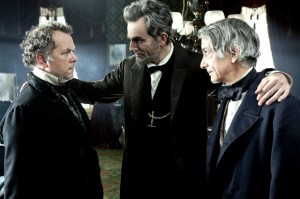 Consider this incongruity: in the movie, Seward (David Strathairn) asks Lincoln, “since when has our party unanimously supported anything?” and yet the correct historical answer to that question is simply the last time the abolition amendment appeared in the House (June 1864) when the ONLY Republican to vote against it was Rep. James Ashley, the sponsor, who did so on technical grounds so that he could bring it back later for reconsideration. By the end of the war, Republicans supported the abolition of slavery –it was a central plank of their party platform in the 1864 election and part of the basis for their landslide victories in November. Border states such as Maryland and Missouri were already in the process of abolishing slavery on their own –with full Republican support. Montgomery Blair had been “pushed out” of the president’s cabinet in September 1864 as part of a deal with radicals –as the movie suggests– but Preston Blair (Hal Holbrook) surely never told Lincoln, as he does in the film: “We can’t tell our people they can vote yes on abolishing slavery unless at the same time we can tell ‘em that you’re seeking a negotiated peace.” It’s not even entirely clear that the elderly and highly controversial Blair had any “people” left in the House now that his other son Frank (Francis Preston Blair, Jr.), a former congressman, was back in the Union army.
Consider this incongruity: in the movie, Seward (David Strathairn) asks Lincoln, “since when has our party unanimously supported anything?” and yet the correct historical answer to that question is simply the last time the abolition amendment appeared in the House (June 1864) when the ONLY Republican to vote against it was Rep. James Ashley, the sponsor, who did so on technical grounds so that he could bring it back later for reconsideration. By the end of the war, Republicans supported the abolition of slavery –it was a central plank of their party platform in the 1864 election and part of the basis for their landslide victories in November. Border states such as Maryland and Missouri were already in the process of abolishing slavery on their own –with full Republican support. Montgomery Blair had been “pushed out” of the president’s cabinet in September 1864 as part of a deal with radicals –as the movie suggests– but Preston Blair (Hal Holbrook) surely never told Lincoln, as he does in the film: “We can’t tell our people they can vote yes on abolishing slavery unless at the same time we can tell ‘em that you’re seeking a negotiated peace.” It’s not even entirely clear that the elderly and highly controversial Blair had any “people” left in the House now that his other son Frank (Francis Preston Blair, Jr.), a former congressman, was back in the Union army.
More important, the so-called Conservative Republicans were not in any sense the obstacle to passage of the amendment. The challenge for the amendment’s backers was to win over Democratic votes, presumably lame duck Democratic votes –not hold together Republicans (at least not on this question). Finally, it’s worth noting that the curious scene involving the White House visit from Mr. and Mrs Jolly of Jefferson City, Missouri is wholly invented (Scene 5). Even their congressman –“Beanpole” Burton– is fictional. This is a perfectly fair use of artistic license, because the imaginary conversation reveals the complicated –and quite real– ambivalence of many Unionists regarding the future of race relations after slavery, but it does seem like a strange choice for filmmakers when there was an important Missouri Unionist congressman named James S. Rollins, whom Lincoln did personally lobby to support this amendment. Why Rollins gets omitted from the movie is difficult to explain.
The Seward Lobby (Scenes 10, 11, 13, 22, 23, 33, 35)
Although “Lincoln” is a serious movie with a high moral purpose, there is still a great deal of comic relief provided mostly by an amusing trio of corrupt lobbyists. What students might find confusing about these figures, however, is that despite the fact that they were “real” men, the movie either totally invents or sometimes just thoroughly rearranges their actual activities. Robert Latham (John Hawkes), Richard Schell (Tim Blake Nelson), and William N. Bilbo (James Spader) were three nineteenth-century political figures authorized by Secretary of State William Henry Seward in the winter of 1864-65 to help promote passage of what ultimately became the Thirteenth Amendment. Historians typically describe these men as the “Seward Lobby” but disagree over exactly how they lobbied for the amendment and to what degree President Lincoln was involved with or aware of their activities. The most in-depth study of the lobbying effort appeared in 1963 and is available in full-text at the Internet Archive. See especially the first chapter (“The Seward Lobby and the Thirteenth Amendment”) in LaWanda and John H. Cox, Politics, Principle, & Prejudice, 1865-66 (1963).
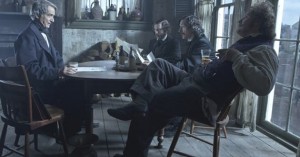 What you will discover by reading this remarkable account is that Latham and Schell were in fact old friends of Seward’s and that Bilbo (James Spader) was a prominent southern attorney and businessman who had switched sides during the war and who was “known for his elaborate waistcoats, his long sideburns, and his elegant manners” (Cox and Cox, p. 6). Bilbo was prominent enough that he actually met with President Lincoln just after the 1864 election and corresponded with him later. Yet the movie introduces these characters as seedy outsiders, completely unknown to the president and forced to rent rooms in a “squirrel-infested attic,” as James Spader puts it memorably (Scene 10), because Seward was keeping them on such a tight retainer. That might be how lobbyists work today –on retainer and often in secret– but it wasn’t quite true then. After passage of the amendment, Latham, a major Wall Street investor (who later went bankrupt following the Panic of 1873), replied indignantly to an attempt by Seward to reimburse the men for their expenses. He wrote in a letter to Seward’s son Frederick, “A Gentleman called to have me give an acct of expenses. Which amt to nothing,” adding, “At any time that I can be of service to the Hon Sec of State or yourself I will do all I can but at my own expence,” (Cox and Cox, p. 24).
What you will discover by reading this remarkable account is that Latham and Schell were in fact old friends of Seward’s and that Bilbo (James Spader) was a prominent southern attorney and businessman who had switched sides during the war and who was “known for his elaborate waistcoats, his long sideburns, and his elegant manners” (Cox and Cox, p. 6). Bilbo was prominent enough that he actually met with President Lincoln just after the 1864 election and corresponded with him later. Yet the movie introduces these characters as seedy outsiders, completely unknown to the president and forced to rent rooms in a “squirrel-infested attic,” as James Spader puts it memorably (Scene 10), because Seward was keeping them on such a tight retainer. That might be how lobbyists work today –on retainer and often in secret– but it wasn’t quite true then. After passage of the amendment, Latham, a major Wall Street investor (who later went bankrupt following the Panic of 1873), replied indignantly to an attempt by Seward to reimburse the men for their expenses. He wrote in a letter to Seward’s son Frederick, “A Gentleman called to have me give an acct of expenses. Which amt to nothing,” adding, “At any time that I can be of service to the Hon Sec of State or yourself I will do all I can but at my own expence,” (Cox and Cox, p. 24).
Yet the Spielberg movie portrays the men in much different light –as rough, political guns-for-hire who curse freely (Bilbo / Spader even says directly to President Lincoln at one point, “Well, I’ll be fucked.”) and who spread bribes easily. The movie makers invent a series of quick scenes involving fictional congressmen and the bribes that it takes to sway them. The most notable example of this corruption involves Rep. Clay Hawkins of Ohio (Walton Goggins) who Bilbo / Spader initially switched with the promise of a postmastership in Millersburg, Ohio. The movie actually has President Lincoln himself commenting cynically on this news by remarking, “He’s selling himself cheap, ain’t he?” (Scene 13). All of this is made up. There was a single lame duck Democratic congressman from Ohio who switched his vote in favor of the antislavery amendment in January 1865 but his name was Wells A. Hutchins and he did not receive any post-war patronage appointment in the federal government. Nor was he much recognizable in the character of Clay Hawkins. In real life, Hutchins was a reasonably tough, independent-minded Democrat who had voted to support the abolition of slavery in the District of Columbia in 1862 and who had backed the Lincoln Administration on several controversial issues during the war, including the suspension of habeas corpus or civil liberties –an issue that was especially unpopular among Ohio Democrats. Understanding this background helps explain why he was a lame duck in 1865 and why he was a natural target for supporting the amendment. It had nothing to do with hunting, drinking or patronage.
Equally important from a strictly historical perspective, there’s no evidence connecting the Seward lobbyists to Hutchins or any Democrat outside of the eastern states. According to LaWanda and John Cox, the lobbyists, especially Bilbo, spent most of their time in New York (not Washington) generally attempting to persuade influential Democratic newspapers (such as the New York World) and the state’s Democratic governor (Horatio Seymour) to send signals that would allow wavering lame duck Democrats to feel more confident about switching their votes.
That is why in some ways the most telling example of “artistic license,” perhaps in the whole film, involves an amusing race between Bilbo / Spader and White House aide John Hay (Joseph Cross) during the day of the final House vote on January 31, 1865. The movie has the two men racing to get Lincoln’s response to reports of impending peace talks –a leak that threatens to jeopardize the entire lobbying effort. The younger Hay beats out the noticeably winded Bilbo, and then President Lincoln proceeds to draft an evasive reply that allows the final roll call to proceed and victory to be achieved. It is a dramatic climax with political machinations and social justice converging in ways that illustrate the film’s major insight about Lincoln –that he understood how a flawed, messy democratic process can be bent toward profoundly moral consequences. However, in real life, Bilbo was in New York at the time of the vote. There was actually an evasive message from the president (more on that below) but no footrace from the Capitol and no significant presence in Washington by the Seward lobbyists during the final fight to win House passage of the amendment.
Thaddeus Stevens and the Radicals (Scenes 9, 10, 17, 28, 34, 39, 42, 43)
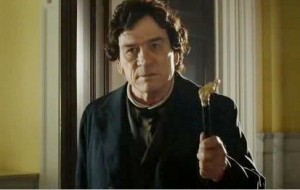 In the scene which introduces the audience to Rep. Thaddeus Stevens (R, PA), the chairman of the House Committee of Ways and Means, the script describes the setting in Stevens’ Capitol Hill office as “redolent of politics, ideology (a bust of Robespierre, a print of Tom Paine), long occupancy and hard work” (p. 30). For historians, such characterizations seem heavy-handed and somewhat out-of-date. Older generations of scholars sometimes referred to the radicals as “Jacobins” (borrowing insulting language from the period) and fixated on the eminently quotable and always crusty Stevens, but in recent years, historians have tried to be more attentive to the complexities of wartime partisanship. For example, the fictional character in the movie named Asa Vintner Litton (Stephen Spinella), described in the script as a lame duck radical Republican from Maryland, seems to be based on Rep. Henry Winter Davis. Yet Davis, despite his radical reputation, had a complicated view about the antislavery amendment. He had missed the June 1864 vote on the amendment (intentionally, according to historian Michael Vorenberg) because he considered his omnibus reconstruction plan (the controversial Wade-Davis Bill, which Lincoln pocket-vetoed that summer) preferable to the separate measures for abolition and reconstruction that had been introduced by Rep. James Ashley (R, Ohio) and were being debated again in January 1865. In the film, however, Rep. Litton is the embodiment of pure radicalism and believes more deeply in Ashley’s amendment than anybody else –even in some ways Ashley himself– calling it “abolition’s best legal prayer.”
In the scene which introduces the audience to Rep. Thaddeus Stevens (R, PA), the chairman of the House Committee of Ways and Means, the script describes the setting in Stevens’ Capitol Hill office as “redolent of politics, ideology (a bust of Robespierre, a print of Tom Paine), long occupancy and hard work” (p. 30). For historians, such characterizations seem heavy-handed and somewhat out-of-date. Older generations of scholars sometimes referred to the radicals as “Jacobins” (borrowing insulting language from the period) and fixated on the eminently quotable and always crusty Stevens, but in recent years, historians have tried to be more attentive to the complexities of wartime partisanship. For example, the fictional character in the movie named Asa Vintner Litton (Stephen Spinella), described in the script as a lame duck radical Republican from Maryland, seems to be based on Rep. Henry Winter Davis. Yet Davis, despite his radical reputation, had a complicated view about the antislavery amendment. He had missed the June 1864 vote on the amendment (intentionally, according to historian Michael Vorenberg) because he considered his omnibus reconstruction plan (the controversial Wade-Davis Bill, which Lincoln pocket-vetoed that summer) preferable to the separate measures for abolition and reconstruction that had been introduced by Rep. James Ashley (R, Ohio) and were being debated again in January 1865. In the film, however, Rep. Litton is the embodiment of pure radicalism and believes more deeply in Ashley’s amendment than anybody else –even in some ways Ashley himself– calling it “abolition’s best legal prayer.”
The film plays fast-and-loose in such minor ways with radical figures, mainly for the sake of simplicity but also sometimes it appears just out of error. “Bluff” Wade is a character in the script identified as a Republican senator from Massachusetts who somewhat implausibly attends the House Republican strategy sessions in Stevens’s office. Presumably, the intention was to make this figure Benjamin “Bluff” Wade, the Republican radical (and Davis’s partner in his failed Reconstruction bill), who was born in Massachusetts but served as a Republican senator from Ohio.
For the sake of simplicity, the film also makes Thaddeus Stevens the central radical figure organizing the amendment’s passage, even more so than the measure’s sponsor, Ashley. This is not how many historians characterize Stevens’s role. He was an important figure, but probably not the central one in securing passage of the Thirteenth Amendment. Stevens had only four index entries in Doris Kearns Goodwin’s Team of Rivals (2005), a nearly 800-page book from which the screenplay was adapted. Stevens plays a somewhat larger role in Michael Vorenberg’s more compact Final Freedom (2001) with seven index entries but even there he is clearly superseded by other figures such as Ashley and Senator Lyman Trumbull (R, IL), who is not even mentioned in the film. The latest and most comprehensive study of wartime abolition policies –James Oakes’s Freedom National (2012)– contains a mere six index entries for Stevens.
By contrast, Stevens (Tommy Lee Jones) has about 45 speaking parts in the Spielberg film, apparently second only to Abraham Lincoln. He looms large as a counter-weight to the president –Lincoln’s near opposite in both style and policy. Their confrontation in the White House kitchen (Scene 17) is one of the movie’s most pivotal scenes and also arguably one of its most historically implausible. Besides the unlikely setting, scriptwriter Tony Kushner seems to be investing many older –and quite hostile– ideas about Stevens into this conversation which contrasts Lincoln’s calculated, pragmatic approach to Stevens’s rigid, ideological worldview. He actually has Stevens / Jones saying at one point, in defense of his sweeping plans for revolutionizing the South, “Ah, shit on the people and what they want and what they are ready for! I don’t give a goddamn about the people and what they want! This is the face of someone who has fought long and hard for the good of the people without caring much for any of ’em.” Such lines (minus the cursing) would be perfectly at home in the captions of D.W. Griffith’s ground-breaking and controversial silent film, “Birth of A Nation” (1915). Griffith’s film depicted Reconstruction as an utter failure in part because of the unyielding attitudes of radicals like Austin Stoneman (the character based upon Stevens). In the kitchen debate between Lincoln and Stevens, scriptwriter Kushner seems to embrace elements of this view. He told NPR, for instance, “The abuse of the South after they were defeated was a catastrophe, and helped lead to just unimaginable, untellable human suffering.”
Still, Kushner’s / Spielberg’s representation of Stevens contains important nuances that save Tommy Lee Jones’s performance from being merely emblematic of the so-called “Lost Cause.” The gripping scene during the House debates where Stevens / Jones restricts himself to endorsing “equality before the law” and nothing more underscores the pragmatic considerations that often motivated Radicals, especially during this moment in the Civil War. However, the scene is also full of small-bore examples of artistic license. The excerpts from the House debates are not real quotations from the Congressional Globe or even apparently from the sometimes more descriptive newspaper accounts. Instead, they appear to be a creative collage of materials pulled together by Tony Kushner from a variety of secondary sources. Michael Vorenberg, for example, quotes Stevens announcing during a different debate –as part of a concerted radical strategy during this period to avoid inflammatory questions about racial equality — that he “never held to that doctrine of negro equality … not equality in all things -simply before the laws, nothing else.” That was on January 5, 1865 –ten days before the movie has Lincoln lecturing Stevens about pragmatism in the White House kitchen and three weeks before it has the congressman saying something similar on the floor of the House (Scene 28). In the movie, Stevens / Jones supposedly states on January 27, 1865 that, “I don’t hold with equality in all things only with equality before the law and 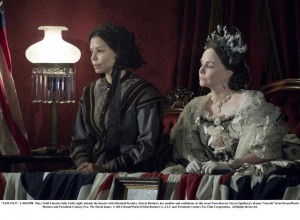 nothing more.” This prompts Mary Lincoln in the House gallery to remark to her black dressmaker, Elizabeth Keckley, “Who’d ever guessed that old nightmare capable of such control?” To this, Keckley excuses herself angrily and leaves. Yet there’s no evidence from any contemporary report or from Keckley’s own recollection that she and Mary Lincoln ever attended the House debates. Instead, what the filmmakers have done here by rearranging events and by inventing selected details is to increase the drama and ultimately to attribute Stevens’s “conversion” to Lincoln’s intervention. Historical accounts give Lincoln no such credit, nor do they present a narrative pulsating with such drama.
nothing more.” This prompts Mary Lincoln in the House gallery to remark to her black dressmaker, Elizabeth Keckley, “Who’d ever guessed that old nightmare capable of such control?” To this, Keckley excuses herself angrily and leaves. Yet there’s no evidence from any contemporary report or from Keckley’s own recollection that she and Mary Lincoln ever attended the House debates. Instead, what the filmmakers have done here by rearranging events and by inventing selected details is to increase the drama and ultimately to attribute Stevens’s “conversion” to Lincoln’s intervention. Historical accounts give Lincoln no such credit, nor do they present a narrative pulsating with such drama.
One final footnote to the presentation of Thaddeus Stevens concerns the filmmakers’ curious decision to place him in bed with his mixed-race housekeeper, Lydia Hamilton Smith, near the very end of the film. This is a reference to widely held suspicion (among contemporaries and historians) that Stevens had a romantic relationship with Smith who stayed with him both in Lancaster and in Washington. Stevens himself never publicly acknowledged this relationship –nor did Smith. They were buried in separate graveyards (Stevens famously in an integrated cemetery in 1868; Smith, who often passed as white, revealingly, was buried in a segregated Catholic cemetery in Lancaster many years later). It may well have been true that they were lovers, but by injecting this issue into the movie, the filmmakers risk leaving the impression for some viewers that the “secret” reason for Stevens’s egalitarianism was his desire to legitimate his romance across racial lines. This type of simplistic connection would appall most historians, but the awkward nature of the revelation (Scene 43) makes it plausible as an interpretation.
Lincoln Family Dynamics (Scenes 2, 3, 12, 15, 16, 18, 29, 30, 31)
No single film could ever hope to capture the range of historical interpretations that have been offered to explain the complicated Lincoln family dynamics. Some historians consider the marriage between Abraham and Mary Lincoln to have been “a fountain of misery.” Others see longstanding affection and partnership. Some find Lincoln to have been essentially an absentee father. Others extol his sensitive parenting toward very different sons. And these debates have proven especially difficult to resolve because the evidence is so thin. Hardly any of the family correspondence remains. None of the family members kept diaries. Almost all of our information about their relationship derives from second- or third-hand accounts, usually recollected after the war.
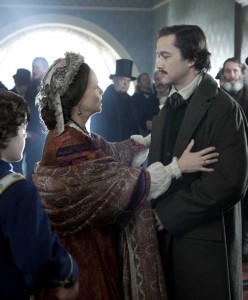 Yet this deficit of evidence also provides scriptwriter Tony Kushner, director Steven Spielberg and actors such as Daniel Day-Lewis and Sally Field with freedom to offer their own interpretations. They can imagine private moments where historians are otherwise forced to remain silent or least circumspect. Two good examples of this occur in the film during Scenes 29 and 30 where President Lincoln engages in loud, back-to-back arguments with his oldest son Robert (Joseph Gordon-Levitt) and then with his wife Mary. In one episode outside a temporary wartime hospital, the president actually slaps his son in anger. This is wholly invented. There is no source for this scene, and it seems entirely implausible to most Lincoln historians, not only because both Lincolns were almost notorious as parents for not disciplining their children, but also because Robert had a reputation for being so outwardly respectful toward his parents. It seems almost impossible to believe that eldest Lincoln son would have told his father, as he does in the movie, “It’s mama you’re scared of, not me getting killed” and that his father would have then lost control and slapped him in public. And yet … it could have happened. There were tensions between father and son, and there was a quiet debate over whether or not Robert should join the Union army. Nonetheless, this is a risky use of artistic license disconnected from any serious evidence.
Yet this deficit of evidence also provides scriptwriter Tony Kushner, director Steven Spielberg and actors such as Daniel Day-Lewis and Sally Field with freedom to offer their own interpretations. They can imagine private moments where historians are otherwise forced to remain silent or least circumspect. Two good examples of this occur in the film during Scenes 29 and 30 where President Lincoln engages in loud, back-to-back arguments with his oldest son Robert (Joseph Gordon-Levitt) and then with his wife Mary. In one episode outside a temporary wartime hospital, the president actually slaps his son in anger. This is wholly invented. There is no source for this scene, and it seems entirely implausible to most Lincoln historians, not only because both Lincolns were almost notorious as parents for not disciplining their children, but also because Robert had a reputation for being so outwardly respectful toward his parents. It seems almost impossible to believe that eldest Lincoln son would have told his father, as he does in the movie, “It’s mama you’re scared of, not me getting killed” and that his father would have then lost control and slapped him in public. And yet … it could have happened. There were tensions between father and son, and there was a quiet debate over whether or not Robert should join the Union army. Nonetheless, this is a risky use of artistic license disconnected from any serious evidence.
The second major argument depicted in the movie is more plausible, but also wholly invented. The script has Mary Lincoln telling her husband that “you’ve always blamed Robert for being born, for trapping you in a marriage that’s only ever given you grief and caused you regret!” The line implies that the Lincoln’s had a shotgun wedding of some sort, but Robert was born almost exactly nine months after their wedding day in the early 1840s. Nor is there any contemporary evidence that Mary Lincoln refused to console their youngest son Tad after his older brother Willie died, or that the president ever threatened her that “for everybody’s goddamned sake, I should have clapped you in the madhouse!” Some of that information (about the “madhouse”) derives from Elizabeth Keckley’s recollected accounts about Mary’s grief in 1862, but most of the vitriol in this exchange is imagined –again, possibly real but certainly not proven by any reliable record.
Nor is there any basis in the historical record for intertwining the story of Robert Lincoln’s late entry into the Union army with his father’s increasingly determined efforts to secure passage of the antislavery amendment. Yet in one of the movie’s more audacious –and improbable– plot twists, scriptwriter Tony Kushner follows the explosive back-to-back family arguments of Scenes 29 and 30 with a revealing trip to the opera that suddenly provides a personal motivation for Lincoln’s new sense of urgency about the amendment’s passage. The script identifies the opera as Gounod’s “Faust” at the Odd Fellows Hall with the president, his wife and Elizabeth Keckley in attendance. In reality, the Lincolns had seen this popular opera with William Seward when it was showing at Grover’s Theater during the previous month, in early December 1864. There is no record of Elizabeth Keckley ever attending theater or opera with the Lincolns and it seems unlikely that she would have remained in the box with the presidential couple while they conversed. Yet Scene 31 has Keckley overhearing how Mary Lincoln finally reconciled herself to the decision about her son’s enlistment. She informs her husband crisply, “I believe you when you insist that amending the constitution and abolishing slavery will end this war. And since you are sending my son into the war, woe unto you if you fail to pass the amendment.” Lincoln at first demurs, claiming, “Seward doesn’t want me leaving big muddy footprints all over town.” But Mary Lincoln is unyielding. “Seward can’t do it,” she claims. “You must. Because if you fail to secure the necessary votes, woe unto you, sir. You will answer to me.”
Final Passage (Scenes 38, 39, 40, 41, 42)
According to the movie’s narrative, Friday, January 27, 1865 was an action-packed and pivotal day. It was the day of Thaddeus Stevens’s controlled performance in the House, declaring himself strictly for “equality before the law.” It was also the day marked by Abraham Lincoln’s bitter argument with his oldest son Robert and then his subsequent clash with his wife Mary after he finally decided to concede to Robert’s desire to join the Union army. And it was in the evening of the 27th that both Mary Lincoln and later dressmaker Elizabeth Keckley urged the president to abandon his hidden-hand approach and provide more decisive leadership in the fight for the antislavery amendment. All of those “events” are fictional, but they are essential for understanding the film’s point-of-view –namely, that Lincoln interjected himself at the end of the battle for the constitutional amendment in a way that proved decisive.
The next several scenes (33-38) subsequently show Lincoln meeting for the first time with the Seward lobbyists, cajoling support for the amendment by himself or with Secretary Seward, and then on the night of Sunday, January 29, 1865, holding an intense penultimate strategy session in the White House with Rep. James Ashley, Preston and Montgomery Blair, Secretary of State William Henry Seward and aides John Nicolay and John Hay. This is one of the scenes (38) that has been featured in the movie’s trailers, showing an angry, forceful Lincoln demanding action “Now now now!” and memorably declaring, “I am the President of the United States, clothed in immense power!”
All of these scenes are entirely fictional, but that memorable quotation from Lincoln actually has its roots in a real primary source. Rep. John B. Alley (R, MA) claimed more than twenty years after the fact that he had heard from some unnamed person during the battle for the amendment that at some point the 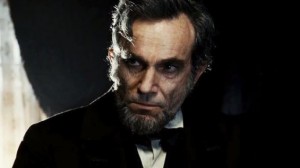 president had called into his office two congressmen in order to tell them that only two more votes were needed for passage and that they “must be procured.” Then Alley’s recollection provided a lengthy verbatim quotation (86 words) which he attributed to Lincoln that culminated with the ringing phrase, “I am President of the United States, clothed with immense power” (note that the script silently changes “clothed with” to “clothed in” –a more fitting usage). The problem is that this quotation is almost completely useless as historical testimony. Alley was recalling events from two decades past that he had apparently heard about second- or third-hand. There are no names, no dates, and the only specific detail –two votes short of the required two-thirds super-majority– seems suspiciously like the final vote tally (two more than needed). Regardless, nobody can be trusted to remember verbatim quotations of such length. Yet Doris Kearns Goodwin quotes the entire passage in her book, Team of Rivals (p. 687) and it appears it was from this account that Kushner got the raw material for his script, which he then embroidered by placing at the very end of the lobbying effort and in a meeting with several of the movie’s principal characters, not simply two unnamed congressmen.
president had called into his office two congressmen in order to tell them that only two more votes were needed for passage and that they “must be procured.” Then Alley’s recollection provided a lengthy verbatim quotation (86 words) which he attributed to Lincoln that culminated with the ringing phrase, “I am President of the United States, clothed with immense power” (note that the script silently changes “clothed with” to “clothed in” –a more fitting usage). The problem is that this quotation is almost completely useless as historical testimony. Alley was recalling events from two decades past that he had apparently heard about second- or third-hand. There are no names, no dates, and the only specific detail –two votes short of the required two-thirds super-majority– seems suspiciously like the final vote tally (two more than needed). Regardless, nobody can be trusted to remember verbatim quotations of such length. Yet Doris Kearns Goodwin quotes the entire passage in her book, Team of Rivals (p. 687) and it appears it was from this account that Kushner got the raw material for his script, which he then embroidered by placing at the very end of the lobbying effort and in a meeting with several of the movie’s principal characters, not simply two unnamed congressmen.
The vote for what ultimately became the Thirteenth Amendment to the U.S. Constitution did occur on January 31, 1865 and the “Lincoln” filmmakers worked diligently to recreate that moment in its full historical grandeur. But they also employ here, as elsewhere, various types of artistic license. None of the floor exchanges from the movie actually match with the official accounts in the Congressional Globe. Instead, the movie takes as its dramatic centerpiece for that day the story of President Lincoln’s evasive reply about impending peace talks. This story derives not from the official record but rather from a recollection by Rep. James Ashley and from copies of notes he claimed he wrote to the president and to which the president replied. According to Ashley, he wrote to the president on January 31:
“Dear Sir, The report is in circulation in the House that Peace Commissioners are on their way or are in the city, and is being used against us. If it is true, I fear we shall loose [sic] the bill. Please authorize me to contradict it, if not true. Respectfully, J.M. Ashley.”
On the reverse side of this note, Lincoln wrote:
“So far as I know, there are no peace Commissioners in the City, or likely to be in it. Jan. 31, 1865. A. Lincoln”
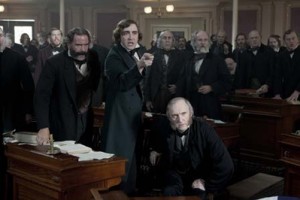 The filmmakers present this exchange in the most dramatic fashion possible, having Democratic leader George Pendleton (D-OH) first disrupt the proceedings, allegedly waving “affidavits from loyal citizens” confirming the existence of secret peace talks. This creates chaos on the floor of the House that leads a fictional “conservative” Republican named Aaron Haddam to indicate (after receiving a critical nod from Preston Blair, perched in the gallery) that the “conservative faction of border and western Republicans” could not support an amendment “if a peace offer is being held hostage to its success.” Then there is a mad footrace from the Capitol to the White House, involving Lincoln’s aides and the Seward lobbyists. John Hay, the president’s young assistant private secretary, heatedly warns him against “making false representation” but Lincoln crafts his reply (technically true but obviously deceptive –since the commissioners were on their way to Hampton Roads, VA) and hands the note to seasoned lobbyist William N. Bilbo (James Spader). Bilbo then delivers it to Rep. Ashley who reads it with a flourish to the entire House. There is no record of any of this in the official proceedings. Nor does Ashley claim in his recollection that he read the note from the president on the House floor. Instead, it seems he may have simply showed it to some key figures. Bilbo was not even in Washington at the time. There was almost certainly no footrace. And no contemporary or historical account has Preston Blair in the gallery giving directions to conservative congressmen. Aaron Haddam is a fictional character, listed as a Republican from Kentucky, with no obvious historical counterpart. All of these details are included in the film for dramatic effect but without any real documentation –beyond the notes which Ashley claimed to have in his possession but which are not apparently available in their original forms, and his recollection of the episode, which most historians have accepted as credible.
The filmmakers present this exchange in the most dramatic fashion possible, having Democratic leader George Pendleton (D-OH) first disrupt the proceedings, allegedly waving “affidavits from loyal citizens” confirming the existence of secret peace talks. This creates chaos on the floor of the House that leads a fictional “conservative” Republican named Aaron Haddam to indicate (after receiving a critical nod from Preston Blair, perched in the gallery) that the “conservative faction of border and western Republicans” could not support an amendment “if a peace offer is being held hostage to its success.” Then there is a mad footrace from the Capitol to the White House, involving Lincoln’s aides and the Seward lobbyists. John Hay, the president’s young assistant private secretary, heatedly warns him against “making false representation” but Lincoln crafts his reply (technically true but obviously deceptive –since the commissioners were on their way to Hampton Roads, VA) and hands the note to seasoned lobbyist William N. Bilbo (James Spader). Bilbo then delivers it to Rep. Ashley who reads it with a flourish to the entire House. There is no record of any of this in the official proceedings. Nor does Ashley claim in his recollection that he read the note from the president on the House floor. Instead, it seems he may have simply showed it to some key figures. Bilbo was not even in Washington at the time. There was almost certainly no footrace. And no contemporary or historical account has Preston Blair in the gallery giving directions to conservative congressmen. Aaron Haddam is a fictional character, listed as a Republican from Kentucky, with no obvious historical counterpart. All of these details are included in the film for dramatic effect but without any real documentation –beyond the notes which Ashley claimed to have in his possession but which are not apparently available in their original forms, and his recollection of the episode, which most historians have accepted as credible.
Then there is the matter of the roll call. It was an unusual affair. The House galleries were crowded, anticipation was high and the celebration afterward was unprecedented. Newspapers and magazines all took note of the revolutionary nature of the moment. Even the Congressional Globe invested this particular roll call with special drama, recording as it rarely did, outbursts of “considerable applause” when certain lame duck Democratic members, such as Rep. James English (D, CT), voted “ay” for the amendment. This has particular meaning in today’s context since there has erupted a small degree of controversy about Connecticut’s votes in 1865. In the “Lincoln” movie version of the roll call, two fictional congressmen from Connecticut cast the very first votes on the amendment –both nays. Yet in reality, the roll call proceeded in alphabetical order by congressman (not by state) and the entire four-man Connecticut delegation actually voted in favor of abolition (because of English’s critical switch). This second fact helped convince modern-day Connecticut congressman Joe Courtney (D, CT) to demand an apology from Steven Spielberg in early 2013 and to request a promise for a correction to the DVD edition of the movie. Scriptwriter Tony Kushner quickly dismissed the request and the affair struck many as a publicity stunt, but New York Times columnist Maureen Dowd then sided with the congressman with an op-ed provocatively headlined, “The Oscar for Best Fabrication.” What Dreamworks might do in the DVD that it promises to make freely available to every middle and high school in America remains to be seen.
Courtney was not the only figure upset by the filmmakers’ decisions regarding the roll call. The script altered dozens of names of representatives in the 38th Congress, some for obscure reasons. The filmed version of the final vote, for example, is full of fictitious names and invented dialogue. One of these characters –Walter H. Washburn of an unidentified state– casts a vote against the amendment. The problem is that there were two Washburns in the 38th Congress –a William Washburn and Elihu Washburne –both Republicans who voted eagerly in favor of the amendment. And naturally, their descendants are now disturbed by the implications of the movie and also want changes or corrections.
Most academic historians are less concerned about the name changes (although they seem strangely unnecessary) and have been more fixated on other minor differences from historical reality. There is the problem of the voting by state (which is a convention of political movies but not the historical Congress). Then the movie has figures in the gallery who were almost surely not there –such as Mary Lincoln and Preston Blair– but omits identifying figures we know to have been present, such as Frederick Douglass’s son, Charles, who wrote a touching letter afterward about the experience to his father. The film also attempts to enhance the suspense of the moment by cutting away to places such as Grant’s headquarters at City Point, Virginia, where there is depicted a telegraph reporting in real time about the voting –something that did not actually happen. And finally, there is the curious decision to have Thaddeus Stevens (Tommy Lee Jones) take the official copy of the amendment from Edward McPherson, the House clerk, claiming that he will “return it in the morning. Creased but unharmed” (Scene 42). One suspects that Tony Kushner must have some kind of source for that unique story –but if so, it is not yet apparent.
Hampton Roads Peace Talks (Scenes 6, 12, 14, 24, 39, 44)

Jackie Earle Haley
One of the several critical strands in the “Lincoln” movie concerns the controversy surrounding the Hampton Roads peace talks (February 3, 1865), where President Lincoln and Secretary of State Seward met with Confederate envoys Alexander Stephens, John Campbell and Robert M.T. Hunter for secret discussions about how to end the war on board the River Queen in Union-controlled Hampton Roads, Virginia (near Fortress Monroe). No transcript exists for their conversations that day. Lincoln and Seward died before leaving any recollection of the affair. So historians have mostly relied upon on the dubious reminiscences of former Confederate Vice President Alexander Stephens. Partly for this reason, many Civil War historians consider the Hampton Roads talks as little more than a sideshow –one of several improbable efforts undertaken in the last year of the war to end the conflict. According to this view, Francis P. Blair, Sr. (Preston Blair / Hal Holbrook in the movie) was just one of several foolish old men (including the famous and eccentric Horace Greeley) attempting foolish things in the name of peace but having little effect. Both Jefferson Davis and Abraham Lincoln were implacable in their positions by the war’s end. Lincoln, for example, made his preconditions for peace clear from July 18, 1864 forward –an end to the rebellion, the restoration of the union, and the abandonment of slavery. Those three conditions never changed, making true “peace talks” impossible. Yet other historians are more willing to take the Hampton Roads conference seriously, since it did result in a real meeting between Confederate envoys and President Lincoln. Doris Kearns Goodwin takes the conference seriously in Team of Rivals (2005), but one of the best accounts available online which considers them significant and details the events surrounding the peace talks comes from an article by William C. Harris in the Journal of the Abraham Lincoln Association.
The article helps illustrate ways that the movie takes major liberties in presenting Hampton Roads. The movie has Lincoln meeting with Preston Blair and his children at the Blair House in early January, reluctantly agreeing to secretly “authorize” an unauthorized trip to Richmond for the elder Blair in exchange for their support with the antislavery amendment. In reality, Blair and Lincoln met alone at the White House in December. Lincoln authorized a pass for Blair to travel into enemy lines but not to make any peace overtures. Blair began his journey on January 3, 1865, arriving in Richmond by January 12 and proceeded to outline a wild scheme to Jefferson Davis that included an end to the war followed by a joint expedition of former Confederate and Union troops to remove the French occupation in Mexico. Davis rejected some of Blair’s ideas but agreed to the possibility of talks for ending hostilities between the “two countries.” Blair returned to Washington on January 16 and met with Lincoln on January 18, 1865. The president agreed that Blair could take back to Richmond a message that the president would receive envoys who would be willing to secure peace for “our one common country.” Blair then presented this message to Jefferson Davis on January 21, 1865. Davis subsequently met with Alexander Stephens on January 27. Stephens was his Vice President but also one of his biggest critics. Davis appointed Stephens and two other notable critics of his policies, John A. Campbell and Robert M.T. Hunter, as his envoys (a sign for some historians, by the way, that he wasn’t serious himself about the talks, but wanted to show up his critics). Regardless of the motives, the men traveled toward Union lines on January 29 and met with General Grant on January 30 before they eventually spent the morning of February 3 with Lincoln and Seward.
The movie accelerates and rearranges this timeline pretty ruthlessly. It ignores the fact that Blair took two trips to Richmond (and most of that month) and instead presents him reporting back to Lincoln on or about January 10, 1865 with news that Davis had already appointed his three peace commissioners. Lincoln (Daniel Day-Lewis) then agrees to proceed with the talks if Blair (Holbrook) lobbies for the antislavery amendment. Blair objects to the “horsetrading” but accepts the condition. The next day, Seward (David Strathairn) reveals to Lincoln that he has found out about this deal with Blair and that he objects to it bitterly. “It’s either the amendment or this Confederate peace,” he says sternly. “You cannot have both.” This is a central premise of the movie –one only made possible, however, by rearranging historical chronology and omitting contradictory details. If the movie had accepted the actual timeline of events, then the connections between the peace talks and the amendment would not be so obvious, nor would the motivations of the key figures appear so starkly at odds. In other words, there would be less conflict, less drama and eventually less satisfaction in the movie’s resolution.
The movie also ducks the biggest historical controversy over Stephens’s account of Hampton Roads –one which definitely undermines a key element of the Spielberg message. According to the former Confederate vice president, Lincoln offered to allow southern states to reenter the union by ratifying the Thirteenth Amendment “prospectively,” suggesting that they could take up to five more years to put it into effect. Stephens also claimed that Lincoln offered payments of up to $400 million for the South to abandon slavery. Historian William Harris also cites recollections from the other commissioners Campbell and Hunter indicating that Lincoln offered compensation. There is no corroboration for Stephens’s outlandish claim about prospective ratification (which would be utterly unconstitutional) but there is contemporary evidence that Lincoln did consider paying southern states to end the war and abandon slavery. He drafted such a proposal and presented it to his cabinet on February 5, 1865, which unanimously opposed it. Lincoln then dropped the plan. Whether or not he was serious remains an open question. But it’s revealing that this idea –which certainly threatens to complicate views about Lincoln’s support for abolition– does not appear in the “Lincoln” movie at all. Doris Kearns Goodwin addresses it in her book, Team of Rivals (2005) and William Harris analyzes the issue extensively in his article and in subsequent book, Lincoln’s Last Months (2004), but here perhaps is a good illustration of the difference between works of history and historical fiction.
Conclusion
When “Lincoln” scriptwriter Tony Kushner responded to criticism from the Connecticut congressman over “inaccuracies” in the final roll call vote, he used the occasion to outline his theory about how to distinguish history from historical drama:
“Here’s my rule: Ask yourself, ‘Did this thing happen?’ If the answer is yes, then it’s historical. Then ask, ‘Did this thing happen precisely this way?’ If the answer is yes, then it’s history; if the answer is no, not precisely this way, then it’s historical drama.”

Tony Kushner
The problem with this line of defense is that it’s so simple-minded in its description of history. Historians are not really capable of deciding how things happened “precisely.” They argue over matters large and small, almost endlessly, because their method is totally dependent on evidence –and evidence changes. We routinely find new evidence, even for topics as familiar as Lincoln and the Civil War. Sometimes we discover new ways of looking at old evidence. And once in awhile, sadly, we lose evidence. But it’s all about telling stories with the evidence –at least for historians. For dramatists, the story-telling is accomplished in other ways, usually with the artistry of plot and character. They are not bound, as historians, by the rules of evidence. That is the difference between history and historical fiction and no amount of getting some things “right” can make up for inventing or rearranging other things. But it’s not clear that Kushner acknowledges this reality. He seems to think that he was true to the historical evidence in the “Lincoln” movie. In his response to Rep. Courtney, Kushner makes a sweeping defense of the “historical” nature of his drama, writing:
“The Thirteenth Amendment passed by a two-vote margin in the House in January 1865 because President Lincoln decided to push it through, using persuasion and patronage to switch the votes of lame-duck Democrats, all the while fending off a serious offer to negotiate peace from the South. None of the key moments of that story—the overarching story our film tells—are altered.”
Yet as this guide demonstrates, Kushner altered many “key moments” in this profoundly important historical story. This guide points them out not to condemn the movie, but rather to remind students (and perhaps future filmmakers) that when you read or invoke the phrase, “Based on a true story,” that means it’s not a true story and should neither be judged –nor defended– as one.
GO TO “LINCOLN” MOVIE TEACHER’S GUIDE
Images courtesy of Dreamworks

